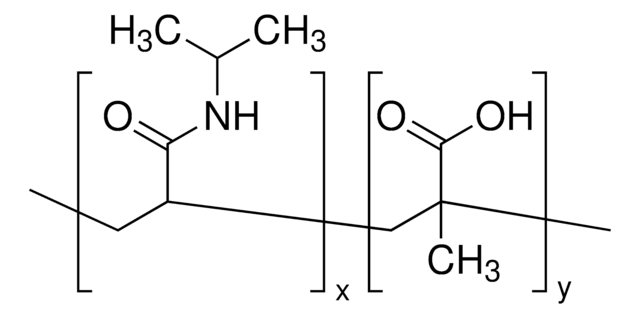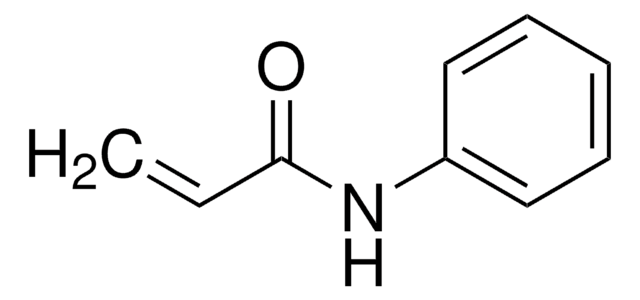All Photos(2)
About This Item
Linear Formula:
H2C=C(CH3)CONHCH(CH3)2
CAS Number:
Molecular Weight:
127.18
EC Number:
MDL number:
UNSPSC Code:
12162002
PubChem Substance ID:
NACRES:
NA.23
Recommended Products
Assay
97%
mp
89-91 °C (lit.)
SMILES string
CC(C)NC(=O)C(C)=C
InChI
1S/C7H13NO/c1-5(2)7(9)8-6(3)4/h6H,1H2,2-4H3,(H,8,9)
InChI key
YQIGLEFUZMIVHU-UHFFFAOYSA-N
Related Categories
Signal Word
Warning
Hazard Statements
Precautionary Statements
Hazard Classifications
Eye Irrit. 2 - Skin Irrit. 2 - STOT SE 3
Target Organs
Respiratory system
Storage Class Code
11 - Combustible Solids
WGK
WGK 1
Flash Point(F)
Not applicable
Flash Point(C)
Not applicable
Personal Protective Equipment
dust mask type N95 (US), Eyeshields, Gloves
Choose from one of the most recent versions:
Already Own This Product?
Find documentation for the products that you have recently purchased in the Document Library.
Customers Also Viewed
J Cautela et al.
Small (Weinheim an der Bergstrasse, Germany), 14(50), e1803215-e1803215 (2018-10-30)
While colloids have been widely employed as models for atoms and molecules, the current study proposes to extend their use as building blocks for supracolloidal frameworks. Hereby, the self-assembly between highly anisotropic supramolecular microtubules and soft spherical fluorescent microgels is
Shalini Saxena et al.
Journal of colloid and interface science, 455, 93-100 (2015-06-10)
We investigate the influence of microgel composition on phase behavior of binary microgel dispersions using poly(N-isopropylacrylamide) microgels cross-linked with 5 mol% and 1 mol% N,N'-methylenebis(acrylamide), or poly(N-isopropylmethacrylamide) microgels cross-linked with 5 mol% N,N'-methylenebis(acrylamide). We then explore the dispersion phase behavior
Loryn E Theune et al.
Materials science & engineering. C, Materials for biological applications, 100, 141-151 (2019-04-06)
Macromolecular bioactives, like proteins and peptides, emerged as highly efficient therapeutics. The main limitation for their clinical application is their instability and potential immunogenicity. Thus, controlled delivery systems able protect the proteins prior release are highly on demand. In the
Sonal Deshpande et al.
Soft matter, 14(20), 4169-4177 (2018-04-25)
RNAi is emerging as a promising technology for treatment of various diseases due to its ability to silence specific target genes. To date, a number of nanoparticle based formulations have been reported for the delivery of small interfering RNA (siRNA)
Adriana M Mihut et al.
Science advances, 3(9), e1700321-e1700321 (2017-09-21)
We have seen a considerable effort in colloid sciences to copy Nature's successful strategies to fabricate complex functional structures through self-assembly. This includes attempts to design colloidal building blocks and their intermolecular interactions, such as creating the colloidal analogs of
Our team of scientists has experience in all areas of research including Life Science, Material Science, Chemical Synthesis, Chromatography, Analytical and many others.
Contact Technical Service











